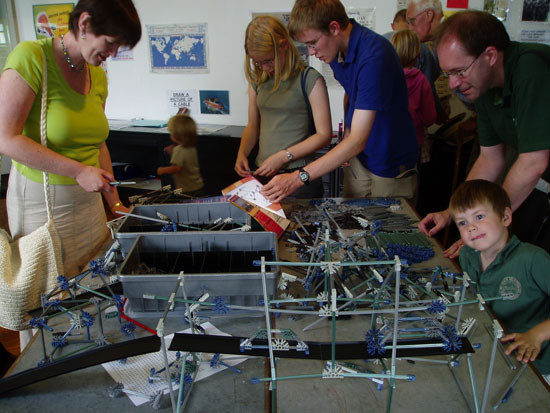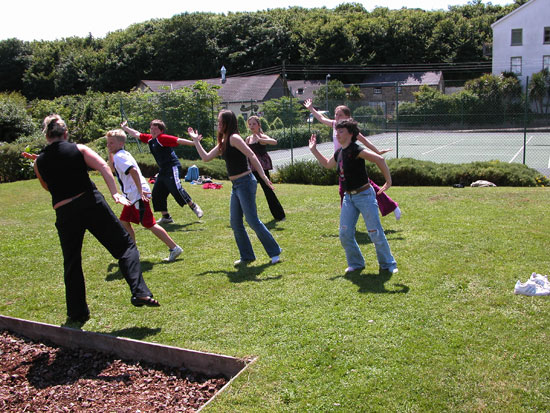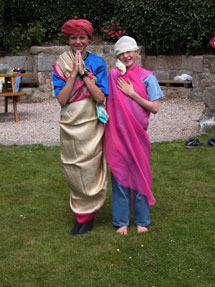|
|



| Celebrating the Great
Eastern |

Celebrating the Great Eastern –
an educational project showing the impact of Brunel’s engineering
genius on the development of international cable communications.
In 1870, Porthcurno began its life
as an important centre of international communications. In this year
a chain of telegraph cables linking Britain with India was completed.
Porthcurno was chosen as the landing point for the British end of this
cable link. The cable was laid across the oceans with the help of Brunel’s
ss Great Eastern, at the time the only ship large enough to enable
engineers to lay and pick up metal cables from the seabed often a mile
below the surface.
Isambard Kingdom Brunel designed the Great Eastern in
1851. Its maiden voyage in 1859 signified the beginning of a gripping,
sometimes terrible but always fascinating story of tenacity and persistence
in the face of great odds. A giant amongst ships, the exhibition 'Brunel's
Great Eastern' is a story about the dreams and ambitions of an era.
During
its 9 cable-laying years, starting in 1865 and ending in 1874, the Great
Eastern made five trans-Atlantic voyages, she laid 3,600 miles of cable
across the Indian Ocean and numerous cables criss-crossing the globe between
the Far East, Australia, Madeira and Brazil, as well as shorter lengths,
which amounts in all to a total of 26,000 miles of cable.
The remote Cornish cove
of Porthcurno became the site of Britain's first major Empire communications
link in 1870.
Porthcurno's telegraphic code name was 'PK'. In 1929
the company also began to operate world radio communications through
a merger with Marconi's radio network. In 1934 the name changed once
again to 'Cable & Wireless'.
At its height, Porthcurno was the world's largest cable station, with
14 telegraph cables in operation.

Family K’nex workshop.
Brunel’s birthday celebrations
To celebrate Brunel’s 200th birthday
year, Porthcurno Telegraph Museum created exhibition panels, ran a series
of workshops, educational visits, lectures and holiday activities and made
links between Mount’s
Bay School and a school in Mumbai, as well as publishing a book and creating
resources for the Museum’s education department.
Lesley Allen, the Museum’s Education and Outreach Manager, also
worked with Penlee House on one of their Brunel 200 funded projects – holiday
workshops in the marquee during the summer break – a perfect example
of partnership!
Schools
The number of schools that participated in Brunel-themed workshops during
2006 was 12 in 20 separate sessions involving over 400 pupils.
Of these
schools, six were new users of the Museum and they all expressed their
determination to continue using Porthcurno Telegraph Museum for further
educational visits. There was a spread of key stage 1, 2 and 3 groups
involved with access themes of ‘Victorians’, ‘Inventors’, ‘Past
Time’, ‘Famous People’ and ‘India’. These
students also included a number of special needs pupils.

Bollywood workshop group.
Workshops and Exhibition
The workshops with schools were extremely successful with excellent feedback
for the schools involved and a wonderful lively atmosphere was created
during the process.
In the summer term of 2006, students from Mounts Bay School in Penzance
came to Porthcurno Museum every day for a week to do some research into
the Porthcurno – Bombay cable of 1870 and establish links with
a school in Mumbai today. The students chose to investigate the themes
of sport, culture, entertainment, cables and The Great
Eastern Steamship.
This information was used to produce a set of six panels to enhance the
existing Brunel exhibition.
The exhibition generated by the students’ work
is now ready for mounting and will feature in the museum during 2007.
Leaflets promoting the exhibition have been distributed to schools.
Jenny
Hick, Advanced Schools Teacher at Mounts Bay School commented:
“I am writing to thank you … for the wonderful welcome we
received this summer. Our pupils all found something to spark their interest
(all 200+ of them), thanks to the imaginative, creative and very patient
approach of you and your volunteers and staff… the Museum really
has hit the nail on the head when trying to grasp pupils’ attention
and encourage them to want to find out more… many thanks… for
a fantastic five days and I do hope we didn’t scare off any of
your visitors with our exuberance!”
Feedback from students:
“I enjoyed my museum visits this week – they
were fun and I learned loads of new things.”
“It isn’t what I expected – I thought it would be like
stuff we do at school but was much better.”
Family visitors and
holiday activities
The Museum put on special events during the summer and half-term holidays which
brought large numbers of family visitors (over 200) into the building. It was
satisfying to see that so many of these family groups were in the gallery, participating
in the activities, for very long periods of time. At least two groups came back
to the Museum at a later date to repeat the experience.
Comments from visitors:
“We couldn’t get the children away from the activities in the gallery…”
“We will definitely recommend this museum to our friends who have children.”
“Brunel was so inspiring – what a shame there don’t seem to
be such brilliant engineers in Britain today.”
|
|

Bollywood
workshop pair. |
Reproduction and distribution of ‘The Wonderful Ship that was
planned by Isambard Kingdom Brunel’, a Victorian children’s
book about Brunel’s ss Great Eastern
This has been very successful with the first reprint edition (5,000)
having all been distributed to schools, libraries, museums etc in the
South West. A second print run of 2,500 was made. The book also has an ISBN number
and, as such, is available to order nationally through booksellers which
will increase its distribution further afield. Contact the Museum for
a copy.
Floor Jigsaws
These were produced in time for the main museum season in 2006 and have
proved very popular with younger visitors and are in use every day.
They will remain in use during 2007 and beyond and are a great addition
to the display about the Great Eastern.
Outcomes of the Brunel 200
project
1. Improved profile amongst local educational establishments
2. Built new relationships with schools that had not previously visited
the Museum
Comments from new schools:
“An excellent facility. I shall bring
other groups here now I know what you do.”
“I will be able to use this experience to support work across the
curriculum. A very good day out for the pupils. Well done.”
“Please keep us on your mailing list. I’m sure other classes
would like to come here too.”
3. Improved resource material available to visiting groups
4. Increased awareness of Brunel and his achievements amongst schools
and a wider audience
Lesley Allen commented:
“Evidence of children’s increased awareness of Brunel came
from listening to the comments of the pupils coming into the museum.
The secondary school students in particular had never heard of Brunel
and asked streams of questions – they certainly knew who he was
by the time they had finished the week! Primary children had generally
been primed before the museum visit so their knowledge started with me
inviting the schools to pick up Brunel as their ‘Study of the Life
of a Famous Person’ which was enhanced by the local connection
(he pushed Richard Trevithick a little off his pedestal!).”
5. Students engaging with science and engineering subjects
“I have learned a lot about Brunel and
the things he built. I would like to be clever and build things like
bridges and ships too.”
6. Increased visitor numbers to the Brunel exhibition
The overall visitor numbers for the museum as a whole increased by about
3% at a time when visitor figures for most other attractions in Cornwall
fell, so this small increase belies the real success of the project in
reaching out to a wider audience.
7. Brought in new audiences, particularly Key Stage 3
8. Addressed the outcomes in the Inspiring Learning for All framework
(IlfA):
Outcomes for users:
• they enjoyed themselves and were enriched and inspired by the
experience
• they developed skills as a result of using the museum
• they became more self-confident, questioning and motivated
• some of them decided to do something different with their lives.
ILfA outcomes for the museum:
• a broader range of people used the museum
• new learning opportunities were developed
9. Built lasting partnerships with other providers (e.g. Penlee House
Museum and Art Gallery in Penzance) who were also delivering activities
through Brunel 200 funding
Legacy
While the existing Brunel exhibition was replaced at Easter
2007, its popularity has prompted the museum to designate a section
of the gallery to a more permanent Brunel and Great
Eastern Steamship exhibition
incorporating the new school material, where it will accessible for
school groups in the future.
The schools’ legacy also includes the
extended exhibition material produced by a local secondary school which
studied the links between Britain and India.
Despite Brunel 200 being all
but over, bookings for a further six Brunel-themed workshops for spring
2007 have been taken, with more enquiries pending. This illustrates the
benefit to the Museum of the Brunel project.
The museum is using the successful
outcomes from the Brunel project as a basis for new fund-raising bids because
it shows that it can deliver such projects effectively.
Contact the Porthcurno Telegraph
Museum at:
Eastern House
Porthcurno
Cornwall
TR19 6JX
01736 810966
Or via: www.porthcurno.org.uk
|
|